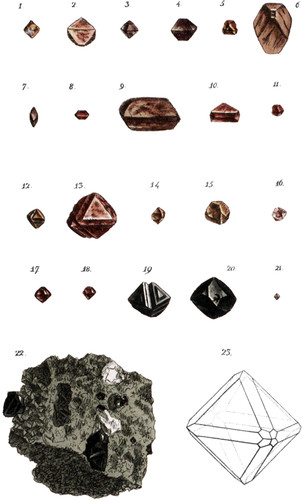 Enlarge
Enlarge
Exotic Mineralogy
Spinel
- Syn.
- Argilla Spinellus. Ex. M. tab. 7. Argilla zincifera. Ex. M. t. 11.
- Rubinus Spinellus et Balassus. Wallerius, 1, 247.
- Spinell & Balass Rubies. Kirw. 1. 253.
- Spinelle. Haüy II. 496. Tabl. 31. Bournon Catal. 33.
- Celanit. La Metherie Journal de Phys. 1793, p. 23.
- Pléonaste. Haüy III. 17. Tabl. 31.
- Spinell, & Zeylonit, of Werner.
Two distinct varieties of Spinel have already appeared in this work: the pale blue from Aker, and the Zinciferous, or Automalite, from Epahlun in Sweden. It remains only to figure the more perfect form of the species, and the variety called Ceylonite. Spinel rubies have only been found on the island of Ceylon; they vary much in tint, hut when the colours are bright, they have an orange hue, that distinguishes them from the oriental rubies, which if high coloured have a peculiar blueish glow, and sometimes incline to purple without losing their brilliancy. On the other hand, the orange varieties of the Spinel are rather purer than those of the oriental ruby. The green, dull blue, and greenish-hlack varieties of Spinel, had for some time been thought to be a distinct species, hut this opinion is now given up, in conformity with the suggestions of Haüy, confirmed by the observations of Bournon. Fig. 17 shows a Spinel of the form that once characterised the Ceylonite (see fig. 23;) and figs. 19 and 20 are from two black crystals of Ceylonite in the British Museum. Fig. 22 shows the same variety imbedded in Augite, with Meiouite, from Vesuvius. The other remarkable crystals upon this plate are, the rhomb, fig. 7; the mackled octohedron with two of the entering angles filled up, fig. 11; the approach to a tetrahedral prism, fig. 14, and to an hexahedral prism, fig. 15, by the truncation of some of the edges of the octohedron: the latter is also mackled; and a lilac octohedron from limestone, ejected by Vesuvius, and which contained myriads of such crystals, fig. 21; I am indebtedto the Countess of Aylesford for a specimen of this.
Figs. 2, 6, and 13 are from the collection in the British Museum; they are remarkable for size as well as form; the first presents an opaque surface, not uncommonly met with: it has an aspect resembling that of flint, which has been exposed to the sun and weather.
The following are the analyses of this mineral hitherto published.
| Spinel by Klaproth. | By Vauquelin. | ||
|---|---|---|---|
| Argilla | 74.50 | 82.47 | |
| Silex | 15.50 | ||
| Magnesia | 8.25 | 8.78 | |
| Oxide of Iron | 1.50 | Chromic acid | 6.18 |
| Lime | 0.75 | Loss | 2.57 |
| 100.50 | 100.00 | ||
| Argilla | 68 |
| Magnesia | 12 |
| Silex | 2 |
| Oxide of Iron | 16 |
| Loss | 2 |
| 100. |

